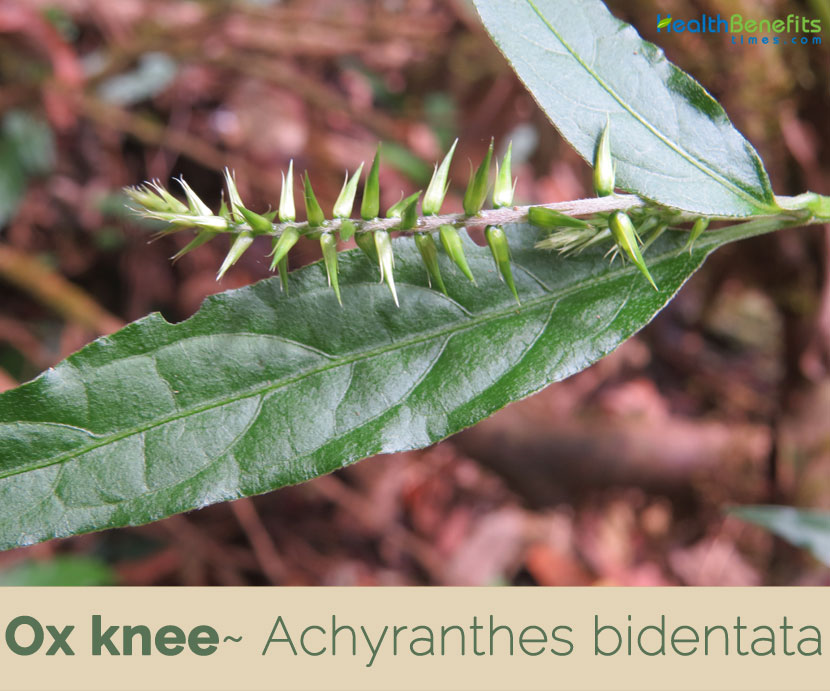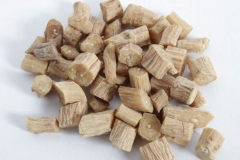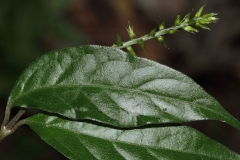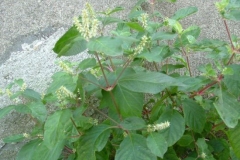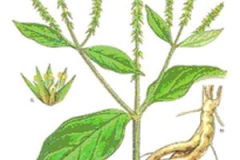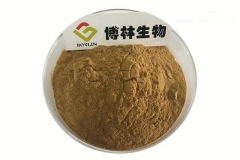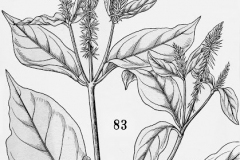| Ox Knee Quick Facts | |
|---|---|
| Name: | Ox Knee |
| Scientific Name: | Achyranthes bidentata |
| Origin | Asia from India and Ceylon eastwards to China, Japan, Indonesia |
| Colors | Reddish-brown |
| Shapes | Achenes 3 mm long and 1.5 mm wide, smooth, cylindrical, longitudinally striate |
| Taste | Bitter, Sour |
| Health benefits | Beneficial for hypertension, back pains, urine in the blood, menstrual pain, bleeding,blood cholesterol, toothache, poor vision, nose bleeds, headache |
| Name | Ox Knee |
|---|---|
| Scientific Name | Achyranthes bidentata |
| Native | Asia from India and Ceylon eastwards to China, Japan, Indonesia and the Solomon Islands; also in east and west tropical Africa |
| Common Names | Two-toothed Chaff Flower, Ox knee, Pig’s knee, Nui Xi |
| Name in Other Languages | Assamese: Apamarga Chinese: Niu xi (牛膝), Huai Nui Xi English: Pig’s knee, ox knee, Finnish: Kiinantähkähäntä Hindi: Putkanda, Chirchira, onga Japanese: Inokodzuchi (イノコヅチ), hinata-inokozuchi (ヒナタイノコズチ), maruba-inokozuchi (マルバイノコズチ), suberi-hiyu (スベリヒユ), Kannada: Kaadu uttharaani Korean: Soemuleup (쇠무릎), teol soe mu reup (털쇠무릎) Malayalam: Nayaruvichedi,Cherukadaladi, perumkadalaadi (പെരുംകടലാടി) Mizo: Vangvattur, Vangvathlo Nepali: Datiwan (दतिवन्), ratoapamarga (रातो अपमार्ग) Sanskrit: Apamarga Swedish: Oxknä Tamil: nayuruvi (நாயுருவி), Sigappu Nayurivi Thai: H̄̀wy h̄ngū̀c̄hik (ห่วยหงู่ฉิก) Vietnamese: Ngưu tất |
| Plant Growth Habit | Erect or straggling much-branched herb |
| Growing Climates | Western ghats, moist deciduous, evergreen forests, forest edges, the sides of streams and shrubberies, moist shady places and amid bushes |
| Plant Size | 70-120 cm tall |
| Root | Elongated roots measuring about 0.6 cm to 1 cm across and the color of their skin is earthy yellow |
| Stem | Green or tinged purple, angulate or quadrangular, appressed or spreading pubescent, or nearly glabrous to moderately (rarely more densely) hairy, the nodes frequently much shrunken when dry. |
| Leaf | Leaf blade is elliptic-lanceolate or elliptic and measures anything between 2 cm and 10 cm in length and about 1 cm to 5 cm in width |
| Flowering season | August to September |
| Flower | Bracts are narrowly lance shaped, brownish-membranous, 3-5 mm, hairless. Bracteoles are 3.5-5.5 mm |
| Fruit Shape & Size | Achene 3 mm long and 1.5 mm, smooth, cylindrical, longitudinally striate |
| Fruit Color | Reddish-brown |
| Plant Parts Used | Leaves, seeds, stems, roots |
| Seed | Seeds light brown, oblong, 1 mm long |
| Taste | Bitter, Sour |
| Season | September to October |
Leaves
Petioles measure anything between 5 mm and 22 mm. The leaf blade is elliptic-lanceolate or elliptic and measures anything between 2 cm and 10 cm in length and about 1 cm to 5 cm in width. The leaf blades are spiky at the apex, while they are cuneate or wide cuneate at the base. A main margin runs through the length of the leaf blade, which is pubescent on the sides. The spica of the plant is axillary as well as apical.
Flowers
Inflorescences at first dense, finally lax and elongating to as much as 20 cm but commonly about half this length, the inflorescence stalk is 1-4 cm. Bracts are narrowly lance shaped, brownish-membranous, 3-5 mm, hairless. Bracteoles are 3.5-5.5 mm. Tepals are 5, 4-7 mm, the outer longest, all narrowly lance shaped, very acute, with a distinct midrib and 2 obscure or obvious lateral nerves, narrowly pale-margined. Flowering normally takes place from August to September.
Fruits
Fertile flowers are followed by achene that is 3 mm long and 1.5 mm wide, smooth, cylindrical, longitudinally striate and reddish-brown. Seeds are light brown, oblong and 1 mm long.
In traditional Chinese medicine, niu xi is supposed to revitalize blood flow. It is used to stimulate menstruation when a period is delayed or light. The herb is also recommended to ease menstrual pain. It is used to relieve pain in the lower back, particularly where the discomfort is attributable to kidney stones. The herb is also taken as a treatment for canker sores, toothache, bleeding gums, and nosebleeds.
Traditional uses and benefits of Ox Knee
- Roots, leaves and stems are extensively used in Chinese herbal medicine.
- Roots are anodyne, anti-inflammatory, anti-rheumatic, bitter, digestive, diuretic, emmenogogue and vasodilator.
- They act mostly on the lower half of the body and are used in the treatment of aching back and knees and asthenia of the lower limbs.
- Research recommends that they can cause enlargement of the cervix and so this herb should not be used when pregnant.
- Herb is taken internally to treat hypertension, back pains, urine in the blood, menstrual pain, bleeding etc.
- It lowers blood cholesterol levels and so is used in the treatment of atherosclerosis.
- Root juice is used in Nepal in the treatment of toothache.
- Juice is also used in the treatment of indigestion and is considered to be a good treatment for asthma.
- Stem of the plant is used as a toothbrush that is said to be good for the teeth and is also a treatment for pyorrhea.
- The plant can be used fresh or dried.
- Leaves and stems are collected in the summer and are usually crushed for their juice or used in tinctures.
- Roots are harvested from 1 or 2 year old plants in the autumn or winter and usually dried and ground into a powder or used in decoction.
- Plant is used externally in the treatment of leech bites in Mizoram, India and a decoction as a diuretic.
- It clears pus and regulates water metabolism.
- It breaks up blood stasis, unblocks menstruation, and guides blood downward to treat amenorrhea.
- It strengthens sinews and bones and benefits the Joints.
- People apply this herb topically to cure leech bites in Mizoram state of India.
- Decoction prepared from the herb is taken orally in the form of a diuretic.
- The herb is also commonly recommended for treating gynecological disorders such as leucorrhea diseases, emmeniopathy and a variety of antenatal as well as postpartum conditions.
- It is also taken internally for treating high blood pressure, urine in blood, bleeding, menstrual pain and several other conditions.
- When taken internally, this herb also helps to lower the levels of blood cholesterol and, hence, it is often used for treating atherosclerosis.
- Root juice is also taken internally to treat indigestion.
- It is believed that the root is also effective for treating asthma.
- It encourages menstruation and also regulates the periodicity.
- Root extract encourages uterine contraction in pregnant women to facilitate easy delivery.
- It prevents painful urination.
- It stops oozing of blood through the nose.
- This root can help to treat Atherosclerosis.
- Extract from the root is also useful in treating poor vision, nose bleeds, headache, tooth ache and weakness and bleeding in the gums.
- Root extract decreases blood sugar levels.
- It controls the metabolism of water in the body.
- You can use the root extract to clear pus formation anywhere in the body.
- Root extract is useful in improving the enlarged prostate or damaged prostate.
- Methonolic extract of the root has cancer preventing properties.
https://www.youtube.com/watch?v=Lx9PVRBY3mE
Ayurvedic Health benefits of Ox knee
- Swelling: Prepare a paste of Achyranthes Bidentata root, Coix Seed and Phellodendron Amurense Bark. Apply it on the swollen part thrice a day.
- Menses Scanty: Prepare a decoction of Achyranthes Bidentata root, Safflower flower and Akebia Vine stalk. Take it, twice a day.
Culinary Uses
- Seed is a good substitute for cereal grains in bread-making,
- They have often been used for this purpose in famine years.
- Leaves are used as a vegetable in the same manner as spinach.
Other Facts
- Two insect-moulting hormones are found in the roots.
- Stem of the plant is used as a toothbrush that is said to be good for the teeth and is also a treatment for pyorrhea.
Precautions
- Avoid use during Pregnancy and breast feeding.
- Roots are highly poisonous.
- Do not take it if you are experiencing diarrhea or heavy menstruation.
References:
https://www.itis.gov/servlet/SingleRpt/SingleRpt?search_topic=TSN&search_value=20757#null
https://npgsweb.ars-grin.gov/gringlobal/taxonomydetail.aspx?id=1314
https://pfaf.org/user/Plant.aspx?LatinName=Achyranthes+bidentata
https://plants.usda.gov/core/profile?symbol=ACBI9
https://en.wikipedia.org/wiki/Achyranthes_bidentata
https://bie.ala.org.au/species/https://id.biodiversity.org.au/node/apni/2902047
https://indiabiodiversity.org/species/show/228605
https://www.wikidata.org/wiki/Q1151611
http://tn-grin.nat.tn/gringlobal/taxonomydetail.aspx?id=1314
http://www.theplantlist.org/tpl1.1/record/kew-2617516
https://www.flowersofindia.net/catalog/slides/Ox%20Knee.html
http://tropical.theferns.info/viewtropical.php?id=Achyranthes+bidentata
http://www.plantsoftheworldonline.org/taxon/urn:lsid:ipni.org:names:58678-1
https://gd.eppo.int/taxon/ACYFA


